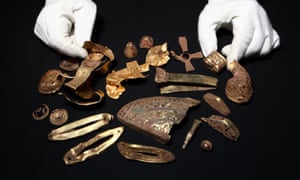
Lift high the cross, the love of Christ proclaim,
till all the world adore his sacred name.
1 Come, Christians, follow where our Saviour trod,
the Lamb victorious, Christ the Son of God. R
2 Led on their way by this triumphant sign,
the hosts of God in unity combine. R
3 Each newborn servant of the Crucified
bears on the brow the seal of him who died. R
4 Saviour, once lifted on the glorious tree,
your death has brought us life eternally. R
5 So shall our song of triumph ever be
praise to the Crucified for victory. R
A long time ago I did my undergraduate studies in art history, a passion which has continued through the decades and is a course of curiosity and delight for me. I've always known the connection between the arts and spirituality, whether it be painting or sculpture or music.
During those studies I learned about the Sutton Hoo ship burial treasure, a hoard of 8th century objects discovered in the 1930's in Britain. Ruth and I saw some of these pieces when we visited the British Museum in 1978.
In 2009 another Anglo Saxon hoard from the 7th century was discovered in Staffordshire. This too was literally a goldmine for researchers, since many of the objects are made from the precious metal. The challenge has been that most of them were in pieces. One of the academics describes it as “a case of multiple jigsaw puzzles being tipped together, mixed up and some of the parts being removed”
A Guardian article says that:
It includes items that are unique, such as a large processional cross that offers convincing evidence, say the experts, that Christian items were being carried into battle in this period as talismans. A curious gold and garnet item, also without parallel and referred to for years as “the mystery object”, is now believed to have been a jewelled ornament that sat on top of a bishop’s headpiece. Both were deliberately bent and desecrated before being buried.

A helmet was reconstructed and replicas made of it, as you can see.
Over the years I have pondered the use of Christian symbols such as the cross as a sort of magic charm in battles. The gospels tell us that the night before he died Jesus admonished Peter for taking up a sword against those who came to arrest him in the Garden of Gethsemane. The humiliating crucifixion became a symbol of suffering love which ran counter to notions of "might makes right" and empire. It is incongruous, to say the least, to use a cross on a field of battle or a field of play, but that has happened often through two millennia.
Even a hymn such as Lift High the Cross, which I do love, has militaristic overtones which I don't love.
Well, enjoy the images, and ponder away, if you will!

No comments:
Post a Comment